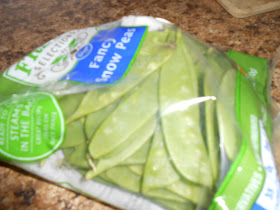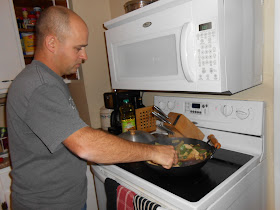Doug & I visited our family in November. My son-in-law, Kevin, has been cooking for his family for quite a long time now. He is a great cook. He has been cooking this particular dish for about 6 months. Kevin confessed that he never ate cashew chicken until Evie wanted him to make it at home. He has tailored this to suit his family's tastes.
This recipe is easy and tastes so good! You will want to make it one of your favorite Chinese recipes for cook-in, not take-out. It is probably faster to just make this, than order it to go.
And, this dish made Kevin's "Family Recipe Cookbook". It will be passed down to his boys.
This recipe was originally taken from www.e-cookbooks.net.
Try it, you won't be disappointed.
Ingredients:
- 3 chicken breasts, boned, skinned
- 1/2 lb. Chinese pea pods
- 1/2 lb. mushrooms (button)
- 2 cups bamboo shoots, drained
- 1- 14 oz. can baby corn (optional)
- 1 cup chicken broth
- 1/4 cup soy sauce
- 2 Tbsp. cornstarch
- 1/2 tsp. sugar
- 1/2 tsp. salt
- 4 Tbsp. salad oil
- 4 oz. whole, salted cashew nuts
- 4 green onions, chopped as garnish (optional)
Printable Version of Recipe: Cashew Chicken PDF
Prep all food before starting to cook.
Cut chicken breast horizontally into thin slices.
This recipe originally calls for cubed chicken,
but it is more tender if it is cut into long, thin slices on the bias.
Continue until all the breasts are sliced, and then set aside.
Always wash hands after handling chicken to prevent cross contamination.
- In the kitchen - harmful bacteria can spread throughout the kitchen and get onto chopping boards, utensils, and bench tops. To prevent this:
- Wash hands with soap and hot water before and after handling raw meat
- Wash chopping boards, dishes, utensils and benches with hot, soapy water after preparing each food item. Preferably, use one chopping board for fresh produce and a separate one for raw meat
- It is not necessary to rinse raw meat before cooking. Studies have shown that rinsing can spread bacteria around the kitchen
- Cook raw meat thoroughly until juices run clear. This is especially important for poultry meat
- When marinating, boil used marinade before brushing onto cooked meat
- When serving, never put cooked food back on the same plate or chopping board that previously held raw meat.
- (from www.foodsmart.govt.nz/foodsafety/high-risk-foods)
Use 1/2 lb. Chinese pea pods.
Original recipe does not call for baby corn.
This is added to accommodate personal tastes of Kevin's family.
Open 1 can baby corn and drain.
Drain 2 cans bamboo shoots.
Wash 1/2 lb. button mushrooms.
Slice them into even slices for uniform cooking.
Kevin prefers using whole cashews rather than slivered or sliced.
You can taste the cashews more with larger pieces.
Measure 4 ozs. whole, salted cashew nuts.
Why wok?
The way a wok is designed, there is a higher concentration of heat in the middle. Foods that are almost done can be moved to the sides to finish cooking them and keep them warm. The bowl shape also makes it easier to catch the food that is tossed and flipped during cooking.
Woks come in different materials, but many chefs prefer carbon steel. Originally, woks were made with two metal handles to make them easy to lift out of a wood stove. These woks are still available; however, Westernized woks have a long wooden handle.
Read more from this Tulsa World article at http://www.tulsaworld.com/scene/article.aspx?subjectid=39&articleid=20120516_39_D1_CUTLIN803768
Heat 2 tbsp. vegetable oil in wok, until it reaches the smoking point.
"What makes stir-frying stir-frying is extreme heat," said Damon Holdeman, executive chef at Te Kei's restaurant at 1616 S. Utica Ave. "As soon as the vegetables hit the pan, they start caramelizing. And when you add the sauces, they caramelize, too."
One of the benefits of cooking at such a high heat is that you need only a little bit of oil, he said.
"Put a small amount of oil in the skillet or wok and heat it until it just starts to smoke," Holdeman said.
Stir-frying is a good cooking method to learn because everything goes in one pan.
Also from: Read more from this Tulsa World article at http://www.tulsaworld.com/scene/article.aspx?subjectid=39&articleid=20120516_39_D1_CUTLIN803768
To the heated oil, add the 4 oz. whole cashews.
Stir constantly and remove from heat as soon as they are browned.
Set the browned cashews aside.
In a separate small bowl measure 1/4 cup soy sauce.
Add 2 Tbsp. cornstarch.
Also add 1/2 tsp. sugar.
And add 1/2 tsp. salt.
Whisk together until blended.
Return oil to wok that was used when removing browned cashews from pan.
You can add enough oil to make 2-4 Tbsp. in bottom of wok.
Heat on high heat to smoking point.
Add sliced chicken.
Stir to prevent sticking and burning.
Initially, cook until opaque on the surface but is not entirely cooked through,
The chicken won't be tough and will continue cooking in the chicken broth.
Add 1 cup chicken broth.
Lower heat so chicken will be tender.
Add pea pods.
Add mushrooms.
Bring to a simmer.
Cover and cook on medium heat 2 minutes.
Then, add 1-14 oz. can of baby corn.
Add 2 cans of bamboo shoots.
Toss ingredients constantly.
Stir in soy sauce thickener.
Simmer, stirring constantly until sauce thickens.
Add browned cashews until warmed through.
Set aside in separate bowl while making rice.
Stir Fried Rice
Pour 2 Tbsp. oil into bottom of wok.
Heat until just to the smoking point.
Use 4 cups prepared cooked rice following the directions on the box.
Left-over rice is perfect to use. If you don't have left-over rice from a previous meal,
cook the rice before hand, and refrigerate it until cold.
We used white rice, but you can use brown rice or whatever you prefer.
Add rice to heated wok.
Add soy sauce to taste.
Nutrition of Soy Sauce
A study by the National University of Singapore showed that Chinese dark soy sauce contains 10 times the antioxidants of red wine, and can help prevent cardiovascular diseases.[24] (However, it is unlikely to be used in nearly as great a quantity as wine.) Soy sauce is rich in lactic acid bacteria and of excellent anti-allergic potential.[25][26] (from wikipedia Soy Sauce)
Stir constantly, to prevent sticking.
Add more soy sauce for a rich, salty, earthy, brown liquid seasoning.
The soy sauce changes the visual appearance of the rice.
History
Soy sauce originated in China sometime in the 2nd century BCE and its use later spread to East and Southeast Asia.[4] Like many salty condiments, soy sauce was probably originally a way to stretch salt, historically an expensive commodity. In ancient China, fermented fish with salt was used as a condiment in which soybeans were included during the fermentation process. Eventually, this was replaced and the recipe for soy sauce, jiangyou (酱油), was created with soybeans as principal ingredient.[5](from Wikipedia Soy Sauce)
Remove from wok.
Heat chicken and vegetables if they have cooled down.
Serve chicken over rice. You can add 4 green onions, chopped as a garnish.
Delicious!
Enjoy!
Thank you, Kevin, for a great day!
Springfield Style Cashew Chicken
Americans have a way of taking traditional ethnic foods and altering them,
sometimes beyond recognition. We call it “Americanizing them,” and no one really
knows whether we do it because we want to change the flavors or simply because
we want to make it our own A little town in the Midwest holds
the honor of being the first to Americanize a great Chinese dish called Cashew
Chicken.
They call it Springfield Style Cashew Chicken, and it has been popular in Southwest Missouri for 30-some years. It achieved notoriety from a New York Times article, but it's the local restaurants that keep it coming at both white linen tablecloth and fast food-type diners throughout the city.
Keep in mind, this isn’t the stir fry item you see on coastal menus. No, this particular style of cashew chicken plays off the Midwest reputation for all things battered, fried, and served with gravy. Talk about homestyle food . . . but with Oriental flare and flavor. (from theFoodChannel.com)
Cashew chicken is Chinese-American dish which was created by Chinese immigrant chef in Springfield, Missouri. This stir fry chicken dish is adaptation of Chinese food to western palates. Cashew chicken simply just stir fry chicken and vegetables in thick savory sauce and cashews are added to make this dish more appealing. There are two kinds of Chinese cashew chicken, one is deep fried chicken pieces coated in savory sauce and healthier version is stir fry cashew chicken.
(from squidoo.com)
They call it Springfield Style Cashew Chicken, and it has been popular in Southwest Missouri for 30-some years. It achieved notoriety from a New York Times article, but it's the local restaurants that keep it coming at both white linen tablecloth and fast food-type diners throughout the city.
Keep in mind, this isn’t the stir fry item you see on coastal menus. No, this particular style of cashew chicken plays off the Midwest reputation for all things battered, fried, and served with gravy. Talk about homestyle food . . . but with Oriental flare and flavor. (from theFoodChannel.com)
Cashew chicken is Chinese-American dish which was created by Chinese immigrant chef in Springfield, Missouri. This stir fry chicken dish is adaptation of Chinese food to western palates. Cashew chicken simply just stir fry chicken and vegetables in thick savory sauce and cashews are added to make this dish more appealing. There are two kinds of Chinese cashew chicken, one is deep fried chicken pieces coated in savory sauce and healthier version is stir fry cashew chicken.
(from squidoo.com)
Kevin made the healthier version.
Chicken cashew is very easy
to make. Forget about Chinese take out or delivery order. You can make a great cashew chicken. Succulent chicken pieces coated with
savory fragrant sauce and crunchy cashew nuts will make this dish a hit among family and friends.
Possibly, even Sheldon Cooper would approve of this Cashew Chicken.
Kevin's has chicken sliced, not diced or shredded and
no low sodium soy sauce or spicy hot mustard and
white rice instead of brown.
(And this is Sunday, not Monday.)
(And this is Sunday, not Monday.)
Kevin's Family Pictures




























































No comments:
Post a Comment